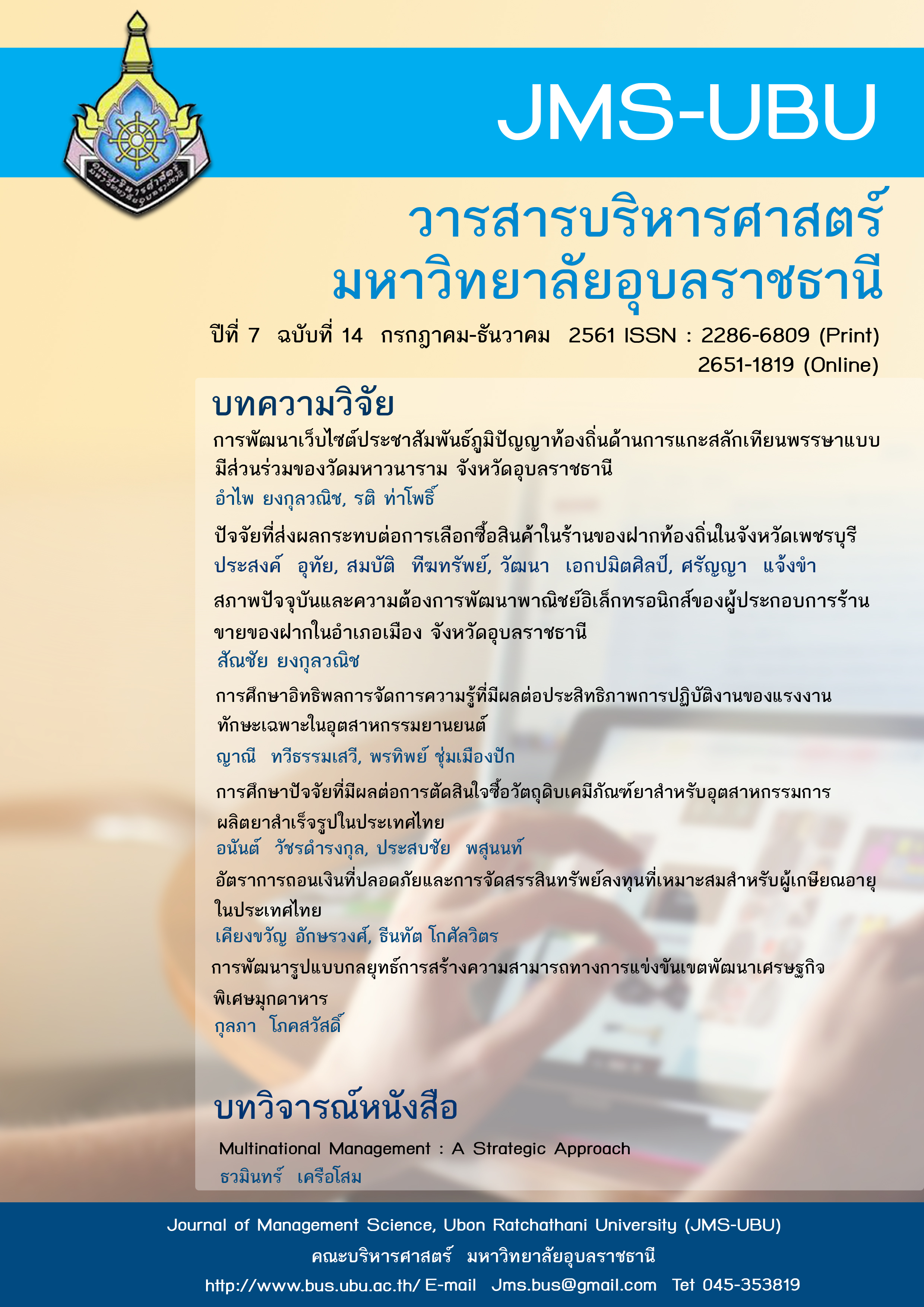อัตราการถอนเงินที่ปลอดภัยและการจัดสรรสินทรัพย์ลงทุนที่เหมาะสม สำหรับผู้เกษียณอายุในประเทศไทย
Main Article Content
บทคัดย่อ
แผนการลงทุนและการใช้จ่ายอย่างเหมาะสมเป็นเรื่องสำคัญที่ส่งผลต่อคุณภาพชีวิตของผู้ที่เกษียณอายุ โดยตามทฤษฎีเกี่ยวกับวัฏจักรชีวิตและการออม ผู้ที่เกษียณอายุจะรับความเสี่ยงได้น้อยลงและการลงทุนจะมุ่งเน้นการรักษาเงินต้นเป็นสำคัญ งานวิจัยนี้จึงมีวัตถุประสงค์เพื่อหาอัตราการถอนเงินที่ปลอดภัยสำหรับผู้เกษียณอายุในประเทศไทย และคำนวณโอกาสที่พอร์ตลงทุนของผู้เกษียณอายุจะประสบความสำเร็จตามจำนวนปีที่มีชีวิตอยู่หลังเกษียณอายุ อัตราการถอนเงิน และการจัดสรรพอร์ตลงทุนที่แตกต่างกัน ข้อมูลที่ใช้ในการวิจัย คือ ดัชนีอัตราผลตอบแทนรวมของ SET50 และดัชนีอัตราผลตอบแทนรวมพันธบัตรรัฐบาลตั้งแต่ปี 2542-2560 วิธีการที่ใช้ในการวิจัย คือ แบบจำลองมอนติคาร์โล (monte-carlo simulation) ผลการวิจัยพบว่า การมีทั้งหุ้นสามัญและตราสารหนี้อยู่ในพอร์ตลงทุนจะช่วยเพิ่มโอกาสในการมีเงินใช้เพียงพอในช่วงเกษียณอายุ โดยในระยะยาวหุ้นสามัญจะช่วยเพิ่มมูลค่าของพอร์ตลงทุน ขณะเดียวกันพันธบัตรรัฐบาลจะช่วยเพิ่มความแน่นอนในการได้รับเงิน และที่อัตราการถอนเงินที่ร้อยละ 4.5 ผู้เกษียณอายุที่มีพอร์ตลงทุนที่ประกอบด้วยหุ้นร้อยละ 20 และพันธบัตรร้อยละ 80 มีโอกาสมากกว่าร้อยละ 95 ที่พอร์ตลงทุนจะมีอายุตั้งแต่ 30 ปีขึ้นไป
Downloads
Article Details
เอกสารอ้างอิง
ฉัตรชัย สิริเทวัญกุล. (2555). การจัดสรรสินทรัพย์ลงทุนที่เหมาะสมกับวัยเกษียณ. ค้นเมื่อ 11 ธันวาคม 2560, จากhttps://www.set.or.th/setresearch/files/cmresearch/2013.05_CMRI_Working_Paper.pdf
ตลาดหลักทรัพย์แห่งประเทศไทย สถาบันกองทุนเพื่อพัฒนาตลาดทุน ศูนย์ส่งเสริมการพัฒนาความรู้ตลาดทุน. (2553ก). หลักสูตรวางแผนการเงิน : ชุดวิชาที่ 4 การวางแผนเพื่อวัยเกษียณ. กรุงเทพฯ : ฝ่ายศูนย์การเรียนรู้ ตลาดหลักทรัพย์แห่งประเทศไทย.
ตลาดหลักทรัพย์แห่งประเทศไทย สถาบันกองทุนเพื่อพัฒนาตลาดทุน ศูนย์ส่งเสริมการพัฒนาความรู้ตลาดทุน (2553ข). หลักสูตรวางแผนการเงิน : ชุดวิชาที่ 2 การวางแผนการลงทุน. กรุงเทพฯ : ฝ่ายศูนย์การเรียนรู้ ตลาดหลักทรัพย์แห่งประเทศไทย.
ตลาดหลักทรัพย์แห่งประเทศไทย (2554). การคำนวณดัชนีผลตอบแทนรวมของตลาดหลักทรัพย์แห่งประเทศไทย (Total Return Index Calculation Methodology) ค้นเมื่อวันที่ 10 มกราคม 2561, จาก https://www.set.or.th/th/products/index/files/2011-10-31-TRI_calculation_Method_Th.pdf
ตลาดหลักทรัพย์แห่งประเทศไทย (2561). ข้อมูลภาพรวมตลาดย้อนหลัง. ค้นเมื่อวันที่ 10 มกราคม 2561, จากhttps://www.set.or.th/th/market/tri.html
บุญเลิศ จิตรมณีโรจน์ และวีระชาติ กิเลนทอง. (2557). การเตรียมพร้อมสาหรับการวางแผนทางการเงินเพื่อวัยเกษียณของกลุ่มแรงงานในระบบ ช่วงอายุ 25 - 39 ปี. ค้นเมื่อ 11 ธันวาคม 2560, จาก https://www.set.or.th/setresearch/files/microstructure/forum20140929_1.pdf
บลจ. ซีไอเอ็มบี พรินซิเพิล จำกัด. (2558) แผนลงทุนสมดุลตามอายุ. ค้นเมื่อ December 19, 2017, จากwww.set.or.th/dat/vdoArticle/attachFile/AttachFile_1444705798367.pdf
สถาบันวิจัยประชากรและสังคม มหาวิทยาลัยมหิดล. (2561). สารประชากร มหาวิทยาลัยมหิดล ปีที่ 27 มกราคม 2561. ค้นเมื่อ 10 มกราคม 2561, จาก http://www.ipsr.mahidol.ac.th/ipsr/Contents/Documents/Gazette/Gazette2018TH.pdf
สมาคมตลาดตราสารหนี้ไทย (2561). Glossary. ค้นเมื่อวันที่ 10 มกราคม 2561, จาก http://www.thaibma.or.th/EN/Education/Bond_Tutor/Glossary.aspx
สำนักงานคณะกรรมการพัฒนาการเศรษฐกิจและสังคมแห่งชาติ. (2556). การคาดประมาณประชากรของประเทศไทย พ.ศ. 2553-2558. ค้นเมื่อ 3 เมษายน 2561, จาก http://social.nesdb.go.th/social/Portals/0/Documents/%E0%B8%81%E0%B8%B2%E0%B8%A3%E0%B8%84%E0%B8%B2%E0%B8%94%E0%B8%9B%E0%B8%A3%E0%B8%B0%E0%B8%A1%E0%B8%B2%E0%B8%93%20e-book.pdf
Bengen, W. (1994). Determining Withdrawal Rates Using Historical Data. Journal of Financial Planning, vol. 7: 171–180.
Blanchett, D. Buffenoir, M. Kemp, D & Watt, S. (2016). Safe Withdrawal Rates for Retirees in the United Kingdom: Where did the 4% rule come from and what is the impact of today’s low bond yields?. Morningstar Research.
Coolye, P. L. Hubbard, C. M. & Walz, D. T. (1998). Retirement savings: choosing a withdrwal rate that is sustainable. AAII Journal February 1998, p.16-21
Coolye, P. L. Hubbard, C. M. & Walz, D. T. (2003). Does International Diversification increase the sustainable withdrawal rates from retirement porfolios. Journal of financial planning, January 2003
Kitco.(n.d.). Historical gold chart. retrieved on December 29, 2017, from https://www.kitco.com/scripts/hist_charts/yearly_graphs.plx
Kitces M. E. (2012). 20 Years of Safe Withdrawal Rate Research. The Kitces Report 03/12 Retrieved 29 December 29, 2017, from http://www.kitces.com
Markowitz, H M. (1952). Portfolio Selection. Journal of Finance, March 1952, pp. 77–91.
Morningstarthailand. (n.d.) กองทุนรวม. Total Expense Ratio. ค้นเมื่อวันที่ 10 มกราคม 2561, จาก www.morningstarthailand.com
Sharpe, W.F., (1964). Capital Asset Prices: A Theory of Market Equilibrium under Considerations of Risk. The Journal of Finance, Vol. 19, No. 3. (Sep., 1964), pp. 425-442.
Srivastava, N. (2008). Advance Age Wise Assets Allocation Method. Retrieved on December 29, from
https://www.researchgate.net/publication/317009367_Advance_Age_Wise_Assets_Allocation_Method

